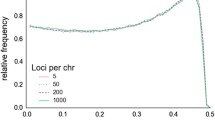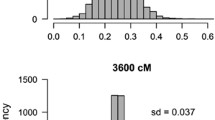Abstract
Analysis of linkage disequilibrium (\(\hat{r}^2\)=mean squared correlation of allele frequencies at different gene loci) provides a means of estimating effective population size (N e) from a single sample, but this method has seen much less use than the temporal method (which requires at least two samples). It is shown that for realistic numbers of loci and alleles, the linkage disequilibrium method can provide precision comparable to that of the temporal method. However, computer simulations show that estimates of N e based on \(\hat{r}^2\) for unlinked, diallelic gene loci are sharply biased downwards (\(\hat{N}_{\rm e}/N <0.1\) in some cases) if sample size (S) is less than true N e. The bias is shown to arise from inaccuracies in published formula for \(E(\hat{r}^2)\) when S and/or N e are small. Empirically derived modifications to \(E(\hat{r}^2)\) for two mating systems (random mating and lifetime monogamy) effectively eliminate the bias (residual bias in \(\hat{N}_{\rm e}<5\)% in most cases). The modified method also performs well in estimating N e in non-ideal populations with skewed sex ratio or non-random variance in reproductive success. Recent population declines are not likely to seriously affect \(\hat{N}_{\rm e}\), but if N has recently increased from a bottleneck \(\hat{N}_{\rm e}\) can be biased downwards for a few generations. These results should facilitate application of the disequilibrium method for estimating contemporary N e in natural populations. However, a comprehensive assessment of performance of \(\hat{r}^2\) with highly polymorphic markers such as microsatellites is needed.
Similar content being viewed by others
References
Akey JM, Zhang K, Xiong M, Doris P, Jin L (2001) The effect that genotyping errors have on the robustness of common linkage disequlibrium measures. Am. J. Hum. Genet. 68: 1447–1456
Anderson EC (2001) Monte Carlo methods for inference in population genetic models. Ph.D. Dissertation, University of Washington, Seattle
Ardren WR, Kapuscinski AR (2003) Demographic and genetic estimates of effective population size (N e) reveals genetic compensation in steelhead trout. Mol. Ecol. 12: 35–49
Bartley D, Bagley M, Gall G, Bentley M (1992) Use of linkage disequilibrium data to estimate effective size of hatchery and natural fish populations. Conserv. Biol. 6: 365–375
Balloux F (2004) Heterozygote excess in small populations and the heterozygote-excess effective population size. Evolution 58: 1891–1900
Beaumont MA (2003) Conservation genetics. In: Balding DJ, Bishop M, Cannings C (eds) Handbook of Statistical Genetics. Wiley, Chicester, UK, pp. 751–792
Berthier P, Beaumont MA, Cornuet J-M, Luikart G (2002) Likelihood-based estimation of the effective population size using temporal changes in allele frequencies: a genealogical approach. Genetics 160: 741–751
Black CW, Krafsur ES (1985) A FORTRAN program for the calculation and analysis of two-locus linkage disequilibrium coefficients. Theoret. Appl. Genet. 70: 491–496
Bucci G, Vendramin GG, Lelli L, Vicario F (1997) Assessing the genetic divergence of Pinus leucodermis Ant. endangered populations: use of molecular markers for conservation purposes. Theoret. Appl. Genet. 95: 1138–1146
Caballero A (1994) Developments in the prediction of effective population size. Heredity, 73, 657–679
Crow JF, Denniston C (1988) Inbreeding and variance effective population numbers. Evolution, 42, 482–495
Crow JF, Morton NE (1995) Measurement of gene frequency drift in small populations. Evolution, 9, 202–214
England PR, Cornuet J-M, Berthier P, Tallmon DA, Luikart G (2006) Estimating effective population size from linkage disequilibrium: severe bias using small samples. Cons. Genet. (this volume)
Frankham R (1995) Effective population size/adult population size ratios in wildlife: A review. Genet. Res. (Cambridge) 66: 95–107
Garnier-Gere P, Dillmann C (1992) A computer program for testing pairwise linkage disequilibria in subdivided populations. J. Heredity 83: 239
Golding GB (1984) The sampling distribution of linkage disequilibrium. Genetics 108: 257–274
Hauser L, Adcock GJ, Smith PJ, Ramírez JHB, Carvalho GR (2002) Loss of microsatellite diversity and low effective population size in an overexploited population of New Zealand snapper (Pagrus auratus). Proc. Nat. Acad. Sci. (US) 99: 11742–11747
Hedgecock D (1994) Does variance in reproductive success limit effective population sizes of marine organisms? In: Beaumont AR (eds) Genetics and Evolution of Aquatic Organisms. Chapman and Hall, London, pp. 122–134
Hedrick PH (1987) Gametic disequilibrium: proceed with caution. Genetics 117: 331–341
Hill WG (1974) Estimation of linkage disequilibrium in randomly mating populations. Heredity 33: 229–239
Hill WG (1981) Estimation of effective population size from data on linkage disequilibrium. Genet. Res. 38: 209–216
Hill WG, Robertson A (1968) Linkage disequilibrium in finite populations. Theoret. Appl. Genet. 38: 226–231
Hudson RR (1985) The sampling distribution of linkage disequilibum under an infinite allele model without selection. Genetics 109: 611–631
Hudson RR (2001) Linkage disequilibrium and recombination. In: Balding DJ, Bishop M, Cannings C (eds) Handbook of Statistical Genetics. Wiley and Sons, New York, pp. 309–324
Krimbas CB, Tsakas S (1971) The genetics of Dacus oleae. V. Changes of esterase polymorphism in a natural population following insecticide control – selection or drift? Evolution 25: 454–460
Laurie-Ahlberg C, Weir BS (1979) Allozyme variation and linkage disequilibrium in some laboratory populations of Drosophila melanogaster. Genet. Res. 32: 215–229
Maruyama T (1982) Stochastic integrals and their application to population genetics. In: Kimura M (eds) Molecular Evolution, Protein Polymorphism, and the Neutral Theory. Springer-Verlag, Berlin, pp. 151–166
Nei M, Tajima F (1981) Genetic drift and estimation of effective population size. Genetics 98: 625–640
Nunney L (1993) The influence of mating system and overlapping generations on effective population size. Evolution 47: 1329–1341
Ohta T, Kimura M (1969) Linkage disequilibrium due to random genetic drift. Genet. Res. 13: 47–55
Pollak E (1983) A new method for estimating the effective population size from allele frequency changes. Genetics 104: 531–548
Pritchard JK, Przeworski M (2001) Linkage disequilibrium in humans: Models and data. Am. J. Hum. Genet. 69: 1–14
Raymond M, Rousset F (1995) GENEPOP (version 1.2): Population genetics software for exact tests and ecumenicism. J. Heredity 86: 248–249
Sinnock P (1975) The Wahlund effect for the two locus model. Amer. Nat. 109: 565–570
Sved JA (1971) Linkage disequilibrium and homozygosity of chromosome segments in finite populations. Theoret. Pop. Biol. 2: 125–141
Sved JA, Feldman MW (1973) Correlation and probability methods for one and two loci. Theoret. Pop. Biol. 4: 129–132
Tallmon DA, Luikart G, Beaumont MA (2004) Comparative evaluation of a new effective population size estimator based on approximate Bayesian computation. Genetics 167: 977–988
Turner TF, Richardson LR, Gold JR (1999) Temporal genetic variation of mtDNA and effective female population size of red drum in the northern Gulf of Mexico. Mol. Ecol. 8: 1223–1230
Vitalis R, Couvet D (2001) Estimation of effective population size and migration rate from one- and two-locus identity measures. Genetics 157: 911–925
Wang J (2001) A pseudo-likelihood method for estimating effective population size from temporally spaced samples. Genet. Res. 78: 243–257
Waples RS (1989) A generalized approach for estimating effective population size from temporal changes in allele frequency. Genetics 121: 379–391
Waples RS (1991) Genetic methods for estimating the effective size of cetacean populations. Rep. Int. Whal. Commn. (special issue 13), 279–300
Waples RS (2002) Definition and estimation of effective population size in the conservation of endangered species. In: Beissinger SR, McCullough DR (eds) Population Viability Analysis. Univ. Chicago Press, Chicago, pp. 147–168
Waples RS (2005) Genetic estimates of contemporary effective population size: To what time periods do the estimates apply? Mol. Ecol., 14, 3335–3352
Waples RS, Smouse PE (1990) Gametic disequilibrium analysis as a means of identifying mixtures of salmon populations. Amer. Fish. Soc. Symp. 7: 439–458
Weir BS (1979) Inferences about linkage disequilibrium. Biometrics 35: 235–254
Weir BS (1996) Genetic Data Analysis, 2nd Edition. Sinauer, Sunderland, MA
Weir BS, Hill WG (1980) Effect of mating structure on variation in linkage disequilibrium. Genetics 95: 447–488
Williamson EG, Slatkin M (1999) Using maximum likelihood to estimate population size from temporal changes in allele frequencies. Genetics 152: 755–761
Wright S (1969) Evolution and the Genetics of Populations. Vol. 2. The Theory of Gene Frequencies. Univ. Chicago Press, Chicago
Acknowledgments
I thank Gordon Luikart and Phillip England for bringing this bias to my attention and François Balloux for sharing an unpublished manuscript. Eric Anderson, Mark Beaumont, François Bonhomme, Craig Busack, Phillip England, Oscar Gaggiotti, Bill Hill, Gordon Luikart, Peter Smouse, David Tallmon, Bruce Weir, and two anonymous reviewers provided useful discussions and/or comments on earlier drafts. I am grateful to Geof Givens for suggesting the algorithm for generating an overdispersed Poisson distribution and to Craig Busack for pointing out the subtleties regarding the correction to \(E(\hat{r}^2)\) for permanent pair bonding. A major part of this research was conducted while the author was a visiting scientist at LECA, and I am grateful to Gordon Luikart and Pierre Taberlet for making that possible.
Author information
Authors and Affiliations
Corresponding author
Additional information
The US Governmentȁ9s right to retain a non-exclusive, royalty-free license in and to any copyright is acknowledged.
Rights and permissions
About this article
Cite this article
Waples, R. A bias correction for estimates of effective population size based on linkage disequilibrium at unlinked gene loci*. Conserv Genet 7, 167–184 (2006). https://doi.org/10.1007/s10592-005-9100-y
Received:
Accepted:
Published:
Issue Date:
DOI: https://doi.org/10.1007/s10592-005-9100-y




